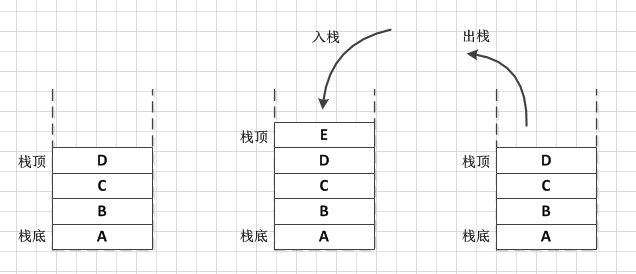Stack&Vector源码解析
前面我们已经接触过几种数据结构了,有数组、链表、Hash表、红黑树(二叉查询树),今天再来看另外一种数据结构:栈。
什么是栈呢,我就不找它具体的定义了,直接举个例子,栈就相当于一个很窄的木桶,我们往木桶里放东西,往外拿东西时会发现,我们最开始放的东西在最底部,最先拿出来的是刚刚放进去的。所以,栈就是这么一种先进后出( First In Last Out,或者叫后进先出) 的容器,它只有一个口,在这个口放入元素,也在这个口取出元素。

栈最主要了两个动作就是入栈和出栈操作,其实还是很容易的明白的对不对,那么我们接下来就看一下Jdk容器中的栈Stack是怎么实现的吧。
1.定义
1 public
2 class Stack<E> extends Vector<E> {
我们发现Stack继承了Vector,Vector又是什么东东呢,看一下。
1 public class Vector<E> 2 extends AbstractList<E> 3 implements List<E>, RandomAccess, Cloneable, java.io.Serializable
发现没有,Vector是List的一个实现类,其实Vector也是一个基于数组实现的List容器,其功能及实现代码和ArrayList基本上是一样的。那么不一样的是什么地方的,一个是数组扩容的时候,Vector是*2,ArrayList是*1.5+1;另一个就是Vector是线程安全的,而ArrayList不是,而Vector线程安全的做法是在每个方法上面加了一个synchronized关键字来保证的。但是这里说一句,Vector已经不官方的(大家公认的)不被推荐使用了,正式因为其实现线程安全方式是锁定整个方法,导致的是效率不高,那么有没有更好的提到方案呢,其实也不能说有,但是还真就有那么一个,Collections.synchronizedList(),这不是我们今天的重点不做深入探讨,回到Stack的实现上。
2.Stack&Vector底层存储
由于Stack是继承和基于Vector,那么简单看一下Vector的一些定义和方法源码:
1 // 底层使用数组存储数据
2 protected Object[] elementData;
3 // 元素个数
4 protected int elementCount ;
5 // 自定义容器扩容递增大小
6 protected int capacityIncrement ;
7
8 public Vector( int initialCapacity, int capacityIncrement) {
9 super();
10 // 越界检查
11 if (initialCapacity < 0)
12 throw new IllegalArgumentException( "Illegal Capacity: " +
13 initialCapacity);
14 // 初始化数组
15 this.elementData = new Object[initialCapacity];
16 this.capacityIncrement = capacityIncrement;
17 }
18
19 // 使用synchronized关键字锁定方法,保证同一时间内只有一个线程可以操纵该方法
20 public synchronized boolean add(E e) {
21 modCount++;
22 // 扩容检查
23 ensureCapacityHelper( elementCount + 1);
24 elementData[elementCount ++] = e;
25 return true;
26 }
27
28 private void ensureCapacityHelper(int minCapacity) {
29 // 当前元素数量
30 int oldCapacity = elementData .length;
31 // 是否需要扩容
32 if (minCapacity > oldCapacity) {
33 Object[] oldData = elementData;
34 // 如果自定义了容器扩容递增大小,则按照capacityIncrement进行扩容,否则按两倍进行扩容(*2)
35 int newCapacity = (capacityIncrement > 0) ?
36 (oldCapacity + capacityIncrement) : (oldCapacity * 2);
37 if (newCapacity < minCapacity) {
38 newCapacity = minCapacity;
39 }
40 // 数组copy
41 elementData = Arrays.copyOf( elementData, newCapacity);
42 }
43 }
Vector就简单看到这里,其他方法Stack如果没有调用的话就不进行分析了,不明白的可以去看ArrayList源码解析。
3.peek()——获取栈顶的对象
1 /**
2 * 获取栈顶的对象,但是不删除
3 */
4 public synchronized E peek() {
5 // 当前容器元素个数
6 int len = size();
7
8 // 如果没有元素,则直接抛出异常
9 if (len == 0)
10 throw new EmptyStackException();
11 // 调用elementAt方法取出数组最后一个元素(最后一个元素在栈顶)
12 return elementAt(len - 1);
13 }
14
15 /**
16 * 根据index索引取出该位置的元素,这个方法在Vector中
17 */
18 public synchronized E elementAt(int index) {
19 // 越界检查
20 if (index >= elementCount ) {
21 throw new ArrayIndexOutOfBoundsException(index + " >= " + elementCount);
22 }
23
24 // 直接通过数组下标获取元素
25 return (E)elementData [index];
26 }
4.pop()——弹栈(出栈),获取栈顶的对象,并将该对象从容器中删除
1 /**
2 * 弹栈,获取并删除栈顶的对象
3 */
4 public synchronized E pop() {
5 // 记录栈顶的对象
6 E obj;
7 // 当前容器元素个数
8 int len = size();
9
10 // 通过peek()方法获取栈顶对象
11 obj = peek();
12 // 调用removeElement方法删除栈顶对象
13 removeElementAt(len - 1);
14
15 // 返回栈顶对象
16 return obj;
17 }
18
19 /**
20 * 根据index索引删除元素
21 */
22 public synchronized void removeElementAt(int index) {
23 modCount++;
24 // 越界检查
25 if (index >= elementCount ) {
26 throw new ArrayIndexOutOfBoundsException(index + " >= " +
27 elementCount);
28 }
29 else if (index < 0) {
30 throw new ArrayIndexOutOfBoundsException(index);
31 }
32 // 计算数组元素要移动的个数
33 int j = elementCount - index - 1;
34 if (j > 0) {
35 // 进行数组移动,中间删除了一个,所以将后面的元素往前移动(这里直接移动将index位置元素覆盖掉,就相当于删除了)
36 System. arraycopy(elementData, index + 1, elementData, index, j);
37 }
38 // 容器元素个数减1
39 elementCount--;
40 // 将容器最后一个元素置空(因为删除了一个元素,然后index后面的元素都向前移动了,所以最后一个就没用了 )
41 elementData[elementCount ] = null; /* to let gc do its work */
42 }
5.push(E item)——压栈(入栈),将对象添加进容器并返回
1 /**
2 * 将对象添加进容器并返回
3 */
4 public E push(E item) {
5 // 调用addElement将元素添加进容器
6 addElement(item);
7 // 返回该元素
8 return item;
9 }
10
11 /**
12 * 将元素添加进容器,这个方法在Vector中
13 */
14 public synchronized void addElement(E obj) {
15 modCount++;
16 // 扩容检查
17 ensureCapacityHelper( elementCount + 1);
18 // 将对象放入到数组中,元素个数+1
19 elementData[elementCount ++] = obj;
20 }
6.search(Object o)——返回对象在容器中的位置,栈顶为1
1 /**
2 * 返回对象在容器中的位置,栈顶为1
3 */
4 public synchronized int search(Object o) {
5 // 从数组中查找元素,从最后一次出现
6 int i = lastIndexOf(o);
7
8 // 因为栈顶算1,所以要用size()-i计算
9 if (i >= 0) {
10 return size() - i;
11 }
12 return -1;
13 }
7.empty()——容器是否为空
1 /**
2 * 检查容器是否为空
3 */
4 public boolean empty() {
5 return size() == 0;
6 }
到这里Stack的方法就分析完成了,由于Stack最终还是基于数组的,理解起来还是很容易的(因为有了ArrayList的基础啦)。
虽然jdk中Stack的源码分析完了,但是这里有必要讨论下,不知道是否发现这里的Stack很奇怪的现象,
(1)Stack为什么是基于数组实现的呢?
我们都知道数组的特点:方便根据下标查询(随机访问),但是内存固定,且扩容效率较低。很容易想到Stack用链表实现最合适的。
(2)Stack为什么是继承Vector的?
继承也就意味着Stack继承了Vector的方法,这使得Stack有点不伦不类的感觉,既是List又是Stack。如果非要继承Vector合理的做法应该是什么:Stack不继承Vector,而只是在自身有一个Vector的引用,聚合对不对?
唯一的解释呢,就是Stack是jdk1.0出来的,那个时候jdk中的容器还没有ArrayList、LinkedList等只有Vector,既然已经有了Vector且能实现Stack的功能,那么就干吧。。。
既然用链表实现Stack是比较理想的,那么我们就来尝试一下吧:
1 import java.util.LinkedList;
2
3 public class LinkedStack<E> {
4
5 private LinkedList<E> linked ;
6
7 public LinkedStack() {
8 this.linked = new LinkedList<E>();
9 }
10
11 public E push(E item) {
12 this.linked .addFirst(item);
13 return item;
14 }
15
16 public E pop() {
17 if (this.linked.isEmpty()) {
18 return null;
19 }
20 return this.linked.removeFirst();
21 }
22
23 public E peek() {
24 if (this.linked.isEmpty()) {
25 return null;
26 }
27 return this.linked.getFirst();
28 }
29
30 public int search(E item) {
31 int i = this.linked.indexOf(item);
32 return i + 1;
33 }
34
35 public boolean empty() {
36 return this.linked.isEmpty();
37 }
38 }
看完后,你说我cha,为什么这么简单,就这么点代码。因为这里使用的LinkedList实现的Stack,记得在LinkedList中说过,LinkedList实现了Deque接口使得它既可以作为栈(先进后出),又可以作为队列(先进先出)。那么什么是队列呢?Queue见吧!
Stack&Vector 完!




